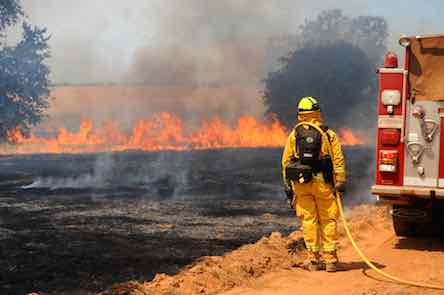
Devastation caused by the recent wildfire outbreak in California reminds those living off-grid to maintain awareness of fire safety. Especially those who live in rural or isolated areas of forestry, writes Levon Barkhordarian.
As it stands the wildfires have forced an estimated 90,000 people to move, destroying more than 5,700 business and homes as well as killing over 40 people. The death toll is expected to rise once the inferno comes to an end, allowing emergency crews to navigate the unpredictable terrain and recover victims.
“The emergency is not over, and we continue to work at it, but we are seeing some great progress,” said California emergency operations director, Mark Ghilarducci. More than 9,000 firefighters are currently fighting the blaze with helicopters, air tankers, and 1,000 fire engines. The director of the California Department of forestry and fire protection, Ken Pimlott described the spread of fires as “a serious, critical, catastrophic event”.
With this in mind, how can businesses, communities and off-grid inhabitants hope to limit the damage caused by the current wildfires and the inevitable fires of the foreseeable future?
There are relatively simple precautionary steps you and your neighbours can adopt to protect your family’s land and property.
Use these examples to protect your property.
- If your property is located near other buildings or you have neighbours close to your land you should discuss plans for collectively tackling fire safety in your area. Creating contingency plans and working together as a team in remote areas can drastically increase your protection.
- Small trees, dead trees and ground fuels such as pine needles and leaves should be cleared from around your property creating at least a 30 to a 100-meter radius of cleared space. Dry leaf litter and debris will significantly increase the chances of fire spreading. So, it is extremely important that you create a clearing around your property to minimise this effect.
- Next, you should prune and cut large tree branches to a height of 10 feet. This inhibits a fires ability to crawl up the trunk of a tree to reach its canopy. If you have conifer trees on your property or other species which you don’t want to discard it is at least worthwhile thinning their branches and crowns to create a partition 10 feet or more apart. This stops the fire from migrating from tree to tree.
- It is a misconception that grassy lawns increase the spread of wildfire, in fact as long as you keep your gardens well-watered and maintain a short length to your grass it should act as a fire breaker. However, it is imperative that you take the time to keep your grass lush and well hydrated.
Extra ways of keeping your property safe from wildfires.
- A major reason so many houses burn down completely is that emergency services such as fire departments find it difficult to access properties in remote locations. To tackle this issue, it is worth thinking about increasing the width of your driveway and clearing its surrounding area from 12 feet wide to 14 feet high. You should also use gravel, stones or concrete to construct your driveway. This will enable easier access to your property and could potentially save your lives and the integrity of your property.
- Another valuable tactic to restrict the spread is to have at least a 10-foot gap between any structure on the property. This should ideally be considered before the construction of your off-grid home as it is essential in preventing a wildfire advance. Also, consider using non-combustible or fire-resistant materials to upgrade your property. Or if you are planning your nexct build, consider if using sustainable concrete would suit your needs — concrete is cheap and can also provide extra protection from fire.
- Keep your roof and drainage gutters clean as sparks from a wildfire can travel in the wind and ignite any dry material it comes into contact with. So, retain the cleanliness of your roof as it is an elevated and exposed area of your home.
- Flammable items such as solvents, paint, gasoline, and other fuels need to be stored in cool ventilated areas far from your properties main structures. You should keep your firewood and fuel at least 100 feet from other main structures. Combining fuel with a wildfire will only increase the intensity of the blaze and risk yourself and your family’s safety.
- In addition, you can also protect your property using natural fire buffers such as fire-resistant plants which have evolved to survive the intensity of a wildfire. So, surround your property with fire-resistant plants especially in the areas you might think are at risk of wildfires.
Here is a selection of fire resistant plants which could save your property.
- Moss Phlox (Phlox Subulata)
- Wild Geranium (Geranium Maculatum)
- California Lilac (Ceanothus Thyrsiflorus)
- red monkey flower (Mimulus Puniceus)
- California Redbud (Cercis Occidentalis)
- Sage Plant (Salvia Officinalis)
For more information regarding fire-resistant plants visit. https://www.readyforwildfire.org/Fire-Safe-Landscaping/
Wildfires in California and around the world are often extremely hard to extinguish. However, by following the simple rules above it is possible to minimise damage and increase your chances of survival.
These are just examples of the different ways you can prevent the damage of wildfires. I advise you to research what would suit your specific situation for greater understanding of how you can apply these tips to your own property.
It is estimated that U.S. taxpayers are paying around $3 billion a year to fight wildfires, of which some of the larger fires can relate to billions of dollars in property losses.